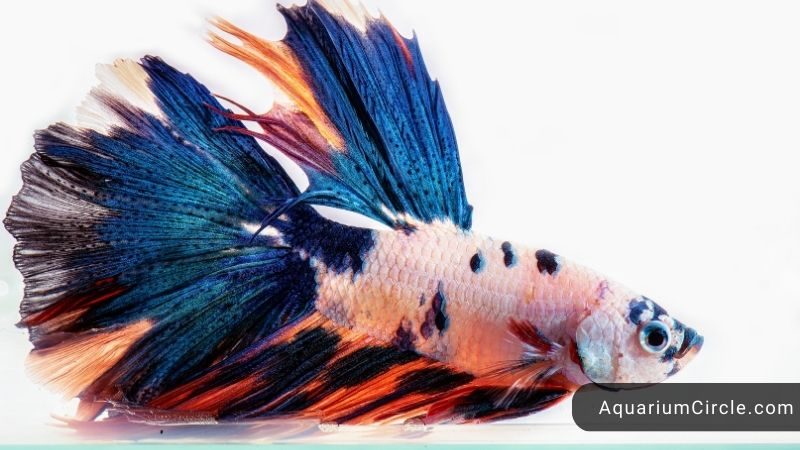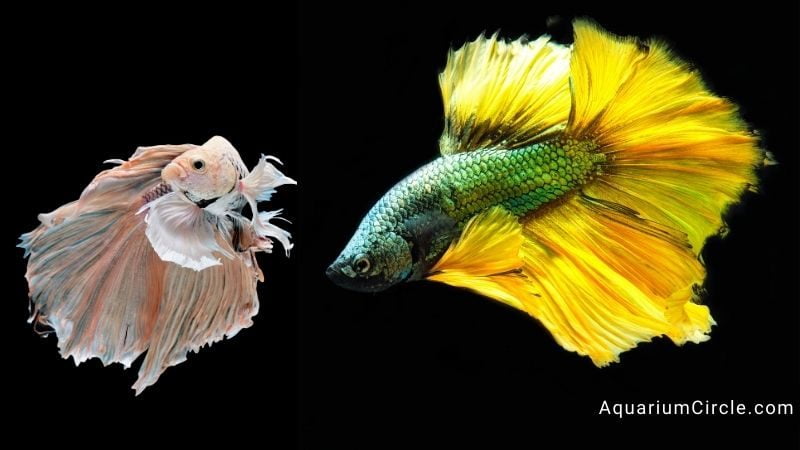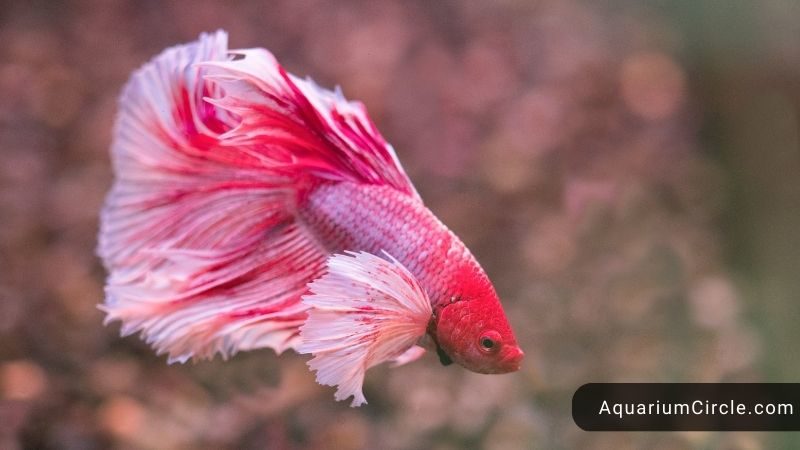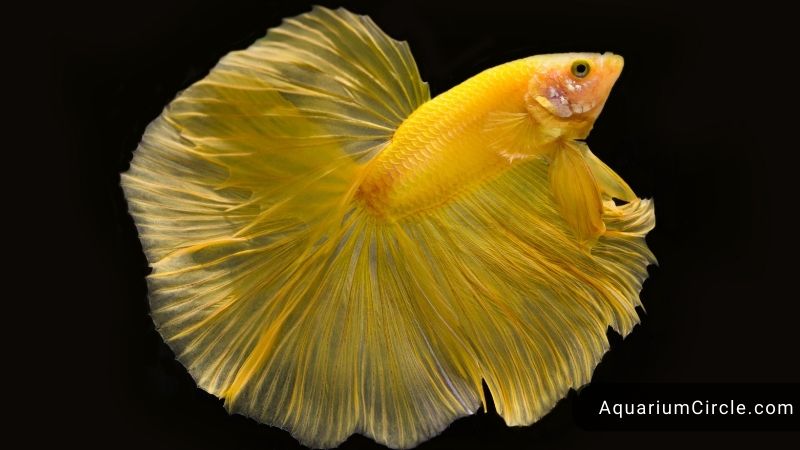Because of their distinctive and lovely appearance, Halfmoon Betta fish is one of the most popular Betta fish. These fish are distinguished by their enormous, half-moon-like tails that may expand to 180 degrees. They are favored by aquarium hobbyists due to their distinctive range of brilliant hues. Let’s study some characteristics of these fascinating small fish in this post.
Halfmoon Betta Fish Overview
In the middle of the 1800s, betta fish (siamese fighting fish) gained popularity in Thailand. They are distinguished by their vivid hues—red, blue, green, purple, and orange—and their broad, flowing fins. The half-moon betta is a popular freshwater fish species. Its stunning color, distinguishing it from much other fish, contributes to its popularity. By the 1890s, keeping halfmoon bettas as pets had become popular throughout Europe, and the species had been transported to France, Germany, and eventually Russia.
The half-moon betta is referred to by its scientific name, Betta splendens. It is a member of the Osphronemidae family. These fish are all from freshwater. The term “halfmoon” refers to the shape of the creature’s tail, which resembles a semicircle.
Betta fish are mistakenly considered to as low-maintenance pets. One explanation is that they have an organ known as a labyrinth that enables them to breathe air at the surface of the water. In reality, bad water quality increases the risk of diseases like fin rot in all tropical fish, including betta.
How To Take Care Of Halfmoon Betta Fish In Aquarium?
Absolutely, a halfmoon betta fish’s general health and well-being depend on how well it is taken care of. A happy life and long lifespan for the fish can be ensured with the right care. Lack of care might cause health problems and possibly reduce the fish’s lifespan. Some points you should notice are down below.
The best tank size
The half-moon betta requires a good amount of room because it is an active species. It won’t last long in a typical fishbowl. A single fish need a tank with a minimum capacity of 5 gallons. Bettas are quite sensitive to changes in their habitat. Your betta will likely live peacefully in a tiny fishbowl, you might be informed. That is untrue.
It is enough for halfmoon betta may have enough room to swim around. Your halfmoon betta will require even more room if you also have other fish in the aquarium. It prefers alone and does not appreciate being in a crowded tank.
Living requirements
After knowing about the best tank size, you should think about the tank environment next. Naturally, the main topic is water conditions. Ideally, water should be just the right temperature. Keeping the water temperature of between 72 and 81 degrees Fahrenheit is recommended, with an excellent average temperature of around 75 degrees (the common temperature requirement). To maintain a steady water temperature, you might want to think about purchasing a water heater to avoid colder water because of the weather. The tranquil water change that medium movement is ideal for halfmoon bettas. Reduce the water flow as much as possible.
The halfmoon betta does not tolerate poor water quality or hard water, so the general hardness of the water should be kept at a moderate level. This fish tank prefers soft water and is at its best in environments with a dGH (degree of General Hardness) range of 5 to 20 with not too much nitrate.
Moreover, the pH level of the water should be kept between 6.8 and 7.5, which is considered to be mild. Water that is either extremely acidic or extremely alkaline will not support the halfmoon betta.
The halfmoons temperament prefers mellow, delicate lighting. It is advised to place a light within the tank but keep the brightness moderate. Also, this species prefers keeping plants in its tank, and these plants require light to survive. Put a few rocks in the tank because the halfmoon betta likes hiding in nooks and crannies.
Food
First, crucial information. Don’t feed your betta too much! Overfeeding your fish could have terrible results and possibly kill them. These tiny fish require less food than you may imagine! Once a week, they also like a cooked, peeled pea.
A carnivorous species is exactly about the half-moon betta. It will therefore consume any little chunks of meat. These tiny fish are excellent candidates for meaty feeds like live brine shrimp or:
- live brine shrimp
- freeze-dried bloodworms
- dried shrimp
- mosquito larvae
How frequently should you feed your half-moon betta? They only require very little food, but it must be provided frequently. These fish benefit from a consistent feeding schedule. Two meals every day, one in the morning and one in the evening, should be given to them. Feeds should be spaced out by around 12 hours each day, and try to stick to the same routine.
Diseases
Like any other fish species, halfmoon betta fish are susceptible to a number of illnesses. The following frequent ailments can affect Halfmoon betta fish:
- Fin rot: a bacterial infection that can make fish fins rot and fall off.
- Ich: The fish’s body and fins develop white spots as a result of this parasitic infection.
- Velvet: causes the skin and fins to develop a yellowish or brownish coating.
- Dropsy: This condition results in the fish bloating and developing elevated scales.
- Swim bladder disorders: swim erratically, float on the surface, or sink to the bottom.
Breeding

In the case that another species of fish inhabits their tank, one or both fish are unlikely to mate. For the goal of breeding, keeping them apart from all other fish and in a separate tank is preferable. The halfmoon betta should be bred when it is between 4 months and 1 year old. This will increase your chances of breeding success with male and female fish.
The male halfmoon betta should be just a little bit bigger than the female halfmoon bettas when breeding. The female will change color and form distinct stripes down the center of her body when she is ready to mate. She will also make her ovipositor visible, which is another sign that she is ready to mate. Between her fins, it will appear like a white spot. Also, in the betta fish reproduction cycle, bubble nests are crucial.
However, many fish will consume their eggs, inhibiting fertile reproduction. It isn’t much you can do to stop your fish from doing this if she inclines to do it.
What Should You Notice When Buying Halfmoon Betta Fish?
How to know which shop we should choose to buy fish from? Here is the answer, purchasing a betta fish from a shop that takes exceptional care of its fish is the best way to ensure that it is healthy. We also discuss a healthy halfmoon betta fish below.
- Are the bettas housed in tiny bowls or cups? If so, you shouldn’t buy your fish here.
- Are the fish vibrant, lively, and able to coexist peacefully with other fish in an aquarium? If so, this is a shop that is knowledgeable about what it is selling.
- If you purchase a fish online, seek a knowledgeable vendor or breeder. Inquire about the conditions under which they maintain the fish and the method of shipping live fish to you.
- Before making a purchase, request to see images of the fish.
How To Prepare New Tank For Halfmoon Betta Fish?

Please remember that you should prepare their tank before you bring your betta home from the store (or get it in the mail).
- Around 24 hours before introducing your new fish, fill the tank, including a simple water conditioner (follow the directions on the bottle). When introducing your fish, the water should be dechlorinated and at the appropriate temperature.
- Put your betta in a container or continue to keep it in the container it came in. 1/4 of the water in the container should be slowly poured out, and tank water should be added in its place.
- Repeat this procedure after 5 to 10 minutes, but take out more water this time.
- Every 5 to 10 minutes, repeat this three times.
- Lastly, release your betta into its new tank using a net.
How Does A Healthy Betta Look?
In addition. Solid hues like red betta, blue, green, black, or white betta halfmoon betta fish also come in multicolored types like marble, koi, and butterfly patterns. Halfmoon bettas with metallic or iridescent scales have a shimmering appearance. Also, there are a few uncommon and distinctive color morphs, like the white platinum and copper metallic hues. In general, many different hues and designs are available for halfmoon betta fish.
Beautiful appearance
If you observe that your half-moon betta’s color starts to change, do not be too shocked. But this can be a cause for worry. When these fish are under stress or are unwell, their vibrant, vivid colors occasionally fade.
This species’ dazzling, glossy colors are almost as brilliant as gems. They come in various hues, including vivid blue, red, shimmering green, sparkling orange, and even varying tones of purple and delicate fins. A white half-moon betta might occasionally be discovered, although these are quite uncommon. The colorless, nearly translucent scales of the albino halfmoon betta are striking. The eyes are pink or crimson, and the skin is shimmering pink.

In general, the coloration of the species’ males is more vivid than that of the females, which is not quite as vivid. Because of the curvature of its tail, this fish is known as the halfmoon betta. The semi-circle has the appearance of a half-moon when it is spread out in all its splendor.
Fish with a half-moon shape are often tiny in size. A half-moon betta will grow to a maximum length of around 2-12 inches when completely mature.
Halfmoon betta fish lifespan
Halfmoon betta fish typically live for 2 to 3 years, but with good care, they can survive for 5 years. Giving your half-moon betta fish a healthy, stress-free habitat, a balanced, nutrient-rich feed, and routine water changes to ensure ideal water quality are the keys to extending their longevity. In order to make sure kids receive the right care, it’s also critical to monitor their behavior and health regularly and to address any problems or diseases as soon as they arise. Your half-moon betta fish can have a long and healthy life if given the right care.
Regular behavior
Halfmoon bettas are frequently observed as lone fish. They prefer being alone and are frequently the happiest when the tank is empty. The male bettas is reputed to be highly aggressive. Normally, if another male betta appears to be encroaching on his area, he will attack. He might put up with females of his own species for a short while.
Nonetheless, this does not preclude their cohabitation in an aquarium with tank mates (other aquarium fish). They can, but it’s crucial to carefully select the fish that will be in their tank with them and to think carefully about what additional fish to put in their tank.
- It is a sign that your fish is pleased if your half-moon betta holds its large fins open, allowing them to wave freely in the water instead of keeping them stiff and taught.
- It’s possible that your betta is stressed out and feels threatened by other fish in its aquarium if its fins are taught and stiff. This could imply that he is preparing for an assault.
- When your betta is content, and at ease, it will be peaceful and swim smoothly, slowly, and gently.
- It is most certainly stressed out if your half-moon betta is swimming erratically and quickly around the tank, smacking into other objects or slamming its nose on the floor.
The half-moon betta may occasionally be able to identify its owner, in which case it will know when it is time to be fed when it sees you. Your betta might start swimming more vigorously and come to the water’s surface as a result.
FAQs
Which fish can live with Halfmoon betta fish?
Peaceful community fish like neon tetras, guppy, and corydoras catfish make good tankmates for Halfmoon Betta fish.
Are Halfmoon betta fish suitable for your tank?
The halfmoon betta has some requirements, despite the fact that caring for it is not too difficult. The halfmoon betta should thrive in your home aquarium if you adhere to all of the above recommendations, particularly with regard to water quality and tank conditions.
How much Halfmoon betta fish cost?
Halfmoon betta fish can range in price from a few dollars to several hundred dollars for unusual or distinctive color patterns, depending on where you get them and the specifics of the fish.
References:
- Siamese fighting fish – https://en.wikipedia.org/wiki/Siamese_fighting_fish
- Betta fish – https://fish.fandom.com/wiki/Siamese_fighting_fish

Annette M. Chaney is an experienced marine biologist with over 20 years of experience as an aquarist and fishkeeper. She started her first aquarium at a young age, filling it with frogs and goldfish obtained from the ten-cent pet store.
Annette grew up caring for and breeding African Cichlids, which led to a hobby in high school that doubled as a profitable means. Attending Reed College gave her time to solidify herself as an accomplished aquarium caretaker with an eye for sales. After that, from 2009 – 2013, she studied at Roger Williams University – one of the most prestigious universities for Aquaculture and Aquarium in USA. She is the founder of AquariumCircle since 2010.
